
1. Introduction
Multimedia technology develops and changes interpersonal communication considerably, which made talking with non-verbal languages like pictures, texts, music etc. becomes a common occurrence. As a result, it unseals the gate to the analysis of multimodal discourses. It set goals to unveil the behind meaning of different modes and attracts quite a few scholars to join. As a result, it starts a rapid development and gradually becomes a new research field where different research paths have formed and flourished. Among which, the most powerful and prosperous one is the path of cooperation between social semiotics and systemic functional grammar (Pan & Li, 2017 [1] ; Kang & Jiang, 2020 [2] ) which this present study will apply. And the following review also converges on this perspective.
Dating back to 1990s, The Language of Displayed Art (O’Toole, 1994 [3] ) and Reading Images: The Grammar of Visual Design (Kress & van Leeuwen, 1996 [4] ) deserve our most attention. They are the foundation stones of social semiotic path. These two works both analyze non-verbal semiotic resources based on systemic-functional grammar (Halliday, 1978 [5] ). The former converges on painting, sculpture, and architecture in order to develop systematic frameworks to analyze them, while the other focuses on images and visual design for the sake of developing principles that are illustrated by analysis.
Notably, the work of Kress and van Leeuwen is the most powerful in later researches. They argue that Halliday’s social semiotic view can analyze images and develop visual grammar. Backed up by Halliday’s three functions, they initiated three meanings accordingly to make systematic analysis of visual mode.
1.1. Researches on Still Images
Backed up by visual grammar, linguists have examined a large amount of examples of images and visual designs for demonstrating the feasibility of visual grammar and made many contributions. And it is observed that scholars usually pay attention to still discourses. For instance, Lemke (2002 [6] ) firstly studies the interaction between visual images and texts in hypertexts like websites to unveil the compound meaning of visual-verbal mode. Knox (2007 [7] ) studies visual-verbal communication on the homepages of online newspapers, describes the emergence of visual grammar and reveals the trend of producing news through different media forms. Hopperstad (2010 [8] ) conducts an ethnographic study on meaning-making in children’s paintings and discusses the similarities between meaning and the motivation behind paintings. Tian and Zhang (2013 [9] ) applies visual grammar to unveil the behind meaning of images in news. Lipovsky (2014 [10] ) investigates the visual design of curriculum vitaes and concentrates on the visual mechanisms by which applicants showcase their professional experience and skills. Wang and Xin (2016 [11] ) pay attention to the interactive meaning of covers both in visual and verbal mode. Maria Grazia Sindoni (2020 [12] ) analyzes texts and images of BeyondBlue, an Australian platform, and applies interactive meaning of visual grammar to elaborate the construction of interpersonal relationships.
In short, scholars at home and abroad all unveil the behind meaning of texts and still images in various materials such as websites (Lemke, 2002 [6] ; Knox, 2007 [7] ; Maria Grazia Sindoni, 2020 [12] ), paintings (Feng, 2015 [13] ; Teng & Miao, 2018 [14] ; Hopperstad, 2010 [8] ; Liu & Qu, 2014 [15] ), advertisements (Thurlow & Aiello, 2007 [16] ; Lirola & Chovanec, 2012 [17] ; Zhang, 2012 [18] ; Li, 2013 [19] ), news (Macken-Horarik, 2003 [20] ; El Refaie, 2003 [21] ; Tian & Zhang, 2013 [9] ), curriculum vitaes (Lipovsky, 2014 [10] ), covers (Zheng & Zhang, 2015 [22] ; Wang & Xin, 2016 [11] ), traffic sign (Zhang & Wang, 2011 [23] ) and so on.
1.2. Researches on Dynamic Images
As for dynamic discourses, although there are fewer achievements than still images, researchers do have gained some tentative achievements in testing the existing theoretical frameworks, especially visual grammar, and its origin―functional grammar. Among which, the most powerful one is Multimodal Film Analysis (Bateman and Schmidt, 2012 [24] ). This book relates visual grammar with film theories initiatively and proposes a systematic framework of meaning construction in filmic discourses. However, there is still rare analysis on filmic discourses, and it is the gap for us to fill. Xu (2013 [25] ) converges on the analysis of dynamic advertisements of CCTV backed up by visual grammar. Pan (2016 [26] ) combines metaphor with social semiotic analysis, and develops a cognitive-functional approach to analyze dynamic multimodal discourses. In 2017, Pan and Zheng apply this approach to study the metaphor and metonymy in dynamic national defense discourses and compare the Chinese and American conscription videos [27] . And Liu (2020 [28] ) applies visual grammar to unveil the metaphor construction of a dynamic advertisement named “Wu Kong”.
In short, multimodal discourse analysis on dynamic discourses is much less than still discourses. And comparatively speaking, most scholars pay attention to dynamic advertisements (Xu, 2013 [25] ; Liu, 2020 [28] ) or videos (Pan, 2016 [26] ; Pan & Zheng, 2017 [27] ). But filmic discourses, natural multimodal discourses, are rarely studied and deserve more attention.
Overall, multimodal discourse analysis has generally converged on still images, while studies on dynamic images, especially filmic discourses, are relatively scarce. As Feng (2014 [29] ) notes, in view of the intricate construction of filmic discourses, the meaning construction of them based on systemic social semiotics has just begun. This is the innovation of this paper. Besides, visual grammar, confirmed feasibility by lots of scholars, is a convincing theory. Therefore, the present thesis aims to use it to analyze the film Frozen to unveil the behind interactive meaning transmittal of this film, and it may serve as an expansion of dynamic discourse analysis, and be propitious to elaborate the transmittal of interactive meaning in filmic discourses.
2. Research Methodology
In this thesis, the author explored the dynamic images and made a comprehensive analysis to find out how the visual mode transmit interactive meaning in the specific scenes of Frozen.
The data were collected in the film Frozen from QQLive app. For the sake of concreteness, the author chose all the interactive scenes between the two heroines to make an analysis. Based on visual grammar (2006 [4] ), the studyemployed qualitative approach to hold a case study of the interactive meanings in 5 scenes from the animated film Frozen.
3. Theoretical Framework
Interactive meaning is the most essential one among three meanings of images because of its communicative feature. And it mainly analyzes relations between 1) the represented symbols; 2) the represented symbols and audience; 3) the audience. And in simple words, represented symbols are the objects or persons in the images while audience refers to the audience of the images.
Interactive meaning relates to contact, social distance, perspective, and modality (Kress & van Leeuwen, 2006 [4] ).
3.1. Contact
In visual grammar, visual discourses express their meaning through “image act” which consists of “demand act” and “offer act”.
“Demand act” is typically featured with the direct gaze from the represented symbols to audience. In this situation, the represented symbols can be persons, animals, or any personified objects. They gaze and talk with audience to demand audience’ attention and assume the presence of audience which invites audience to be involved in imaginary relations. And gestures or facial expressions are often used to amplify “demand act”.
One the contrary, “offer act” is featured without direct visual contact. The represented symbols can be any creatures or objects and audience are just bystanders or passers-by to see what is happening.
In simple words, “demand act” refers to that represented symbols demand attention from audience while “offer act” means the represented symbols offer information to audience.
3.2. Social Distance
Social distance can reveal the level of affinity between participants. Like in daily life, shorter distance usually means closer relation. And in visual discourses, the choices of “close-up shot”, “medium shot” and “long shot” suggest the interpersonal relations from intimacy to separation. “Close-up shot”, focusing on heads and shoulders or participants’ bodies above waists, suggests intimate or personal relation. “Medium shot”, showing the whole bodies of participants, signifies social distance when people conduct business or other interactive activities. “Long shot”, exhibiting the whole bodies and background, identifies the distance between strangers.
3.3. Perspective
Perspective, related to the angle, can be mainly split into horizontal angle and vertical angle. And horizontal angle covers frontal angle and oblique angle. When the represented symbols face to audience directly, a front angle is constructed and it seems that audience are involved in the same situation with the represented symbols. On the contrary, oblique angle signifies separation.
As for vertical angle, it covers high angle, eye-level angle, and low angle. They can imply the power relations. With a high angle, the audience needs to look down to see the represented symbols, which implies the represented symbols don’t have more power than the audience. An eye-level angle suggests equality. And a low angle forces the audience to look up to see the represented symbols which signifies they are more powerful than the audience.
3.4. Modality
Modality, the degrees of credibility, contains high, medium, and low modality. Because the producers of visual discourses can control and change the atmosphere or objects to tell us stories, real or imaginary. High modality means involvement while low modality means detachment. And this thesis will apply color, contextualization, and representation to extend an analysis.
Color covers color saturation, color differentiation and color modulation to unveil natural modality. Color saturation converges on the brightness of colors. Color differentiation focuses on the diversity of colors. And color modulation means the variation of a certain color. In most situations, the higher the three scales are, the more natural modality will be. But when these scales reach in peaks, the natural modality will decrease because of overly full and vivid colors.
Contextualization is about how detailed the background is shown. In normal situations, background is always less detailed than the represented symbols. So, modality increases when the background becomes less detailed to some extent.
Representation is concerned with whether the represented symbols are detailed. And modality increases following a higher representation to some extent. Similarly, when the scale of representation reaches in a peak, the modality will decrease due to too many details.
4. The Analysis of Frozen
4.1. Analysis of Scene 1
Scene 1 starts with an oblique, eye-level angle, and a long shot of Elsa sleeping alone in her bedroom (Shot 1). This far distance displays the environment and implies the audience are not involved in this situation. And there is an equality in power between the heroines and the audience.
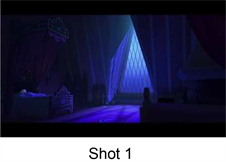
Then Anna emerges and tries to wake Elsa up, the angle turns to be a frontal, eye-level angle, and a medium shot (Shot 2). The relation between the heroines and the audience gets more intimate. And when the two heroines talk with each other, a close-up shot (Shot 3, Shot 4) is applied, which amplifies the two heroines’ facial expression as if audience are involved in this situation.

Finally, scene 1 comes back to an oblique angle and changes between medium and long shot (Shots 5-10) of the two sisters’ playing to show their deep affection to each other and in the end of scene 1, Anna’s head is suddenly hurt by Elsa’s superpower.


The whole scene 1 adopts an eye-level angle which implies there is an equality in power between the two heroines and audience. And there is no demand act at all, audience are like bystanders to see the two sisters’ daily playing. As for the modality, it has a low color saturation and differentiation because the main colors are dark purple of the castle and white of snow. And it reveals that the time is before sunrise. Also, the contextualization and representation are medium, which are matched with the time―before sunrise.
4.2. Analysis of Scene 2
The coronation party of Elsa is hold in castle and all the guests are dancing. Elsa and Anna are standing in front of guests, they haven’t met each other for so long years, but their communication changes the awkward atmosphere.
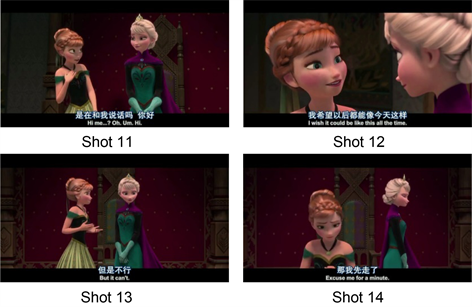
In scene 2, the producer mainly adopts a frontal and eye-level angle, and changes between close-up and medium shot (Shots 11-14). The choice of shot suggests that audience are the viewers of this coronation. And the angle makes audience feel they are in the castle together with the two heroines.
Same as scene 1, scene 2 doesn’t have demand act. It offers audience the information about the two sisters’ talks through offer acts in the whole scene 2. At the mention of modality, the color saturation and differentiation get higher than scene 1 and become more natural. And the representation and contextualization are adopted to attract audience’ attention to the two heroines as if audience are looking at the represented symbols in the dance hall.
4.3. Analysis of Scene 3
In scene 3, Anna expects to get Elsa’s permission to marry a man she just met, which makes Elsa’s superpower out of control because of anger. Fearing her superpower might hurt others, Elsa leaves the castle.
Scene 3 starts and ends with an oblique angle and a long shot (Shot 15, Shot 16) to show audience what happens while the middle part adopts a frontal angle and a close-up shot (Shot 17, Shot 18) to make audience better feel the emotions of the represented symbols.
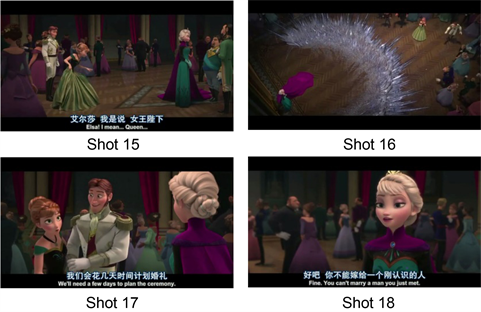
The whole scene 3 is filled of offer acts without any demand act. And as for modality, it is the same as scene 2 mentioned above because they both happens in the dance hall.
4.4. Analysis of Scene 4
In scene 4, Anna finds Elsa’s ice palace and expects to bring Elsa back home and save the frozen Arendelle. However, Elsa’s fear makes her superpower out of control again and she hurts Anna’s heart by ice.
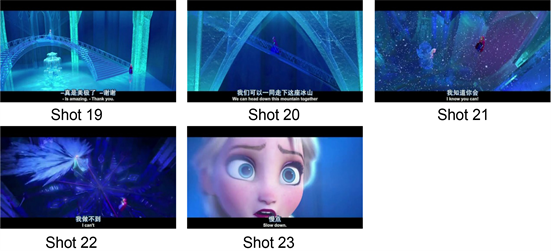
The whole scene 4 mainly uses a long shot and high angle (Shots 19-22) to show audience the beauty of the snow palace to the greatest extent. As for the contact, there is only once that Elsa gazes audience when she thinks of the bad memory of hurting Anna by her uncontrolled power (Shot 23). This demand act demands audience’ attention to Elsa’s fear.
And the choice of colors deserves attention, the whole scene 4 is almost dark blue and bright green which are both cold colors and imply a sense of detachment between Elsa and audience.
4.5. Analysis of Scene 5
In scene 5, Anna gradually gets frozen but she saves Elsa from being killed by an evil prince before she is totally frozen. Elsa is moved and reminded of their deep love towards each other. Finally, love thaws Anna and the whole frozen Arendelle.
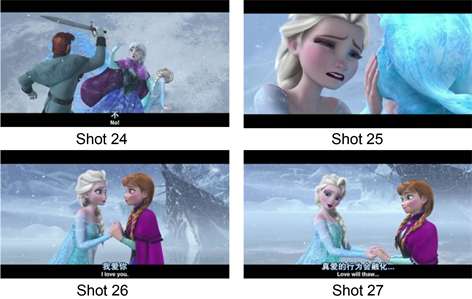
And the whole scene 5 mainly uses close-up shots (Shots 24-27) to narrow the distance between the heroines and audience, and provokes audience’ thought about the theme: love will thaw…
In conclusion, analyzing the 5 selected scenes from the contact aspect, the producer of this film hardly adopts demand acts, the whole film’s highlight point is shown through the development of the story instead of the represented symbols’ gaze.
As for the social distance, the producer applies long shots to depict the environment, like Shots 1, 5, 6, 9, 16, 19-22. Close-up shots are used to exhibit the emotion of the represented symbols and close the distance between them and the audience. Shots 3, 4, 12, 17, 18, 23-27 are all good instances. And the extra Shots are all medium shots.
For the perspective, this film always uses the eye-level angle to show that there is no inequality between the heroines and audience. And most scenes apply the frontal angle to make audience seem are in the environment while some rare scene, like Shot 1, adopts an oblique angle, and bring out a sense of mystery.
At the mention of modality, the colors of these scenes are almost cold colors like dark purple, blue, and white. The producer chooses these limited numbers of colors to suggest a sense of cold of both the snow world and Elsa’s detachment from others. Besides, the producer is good at controlling the contextualization and representation. He makes a perfect balance between the depiction of settings and represented symbols. When the two heroines are talking, they will be highlighted with background less clear and sharp. And when he concentrates on exhibiting the environment (Shots 1, 19-22), the depiction of the heroines will be less detailed.
5. Conclusion
Just as Thompson mentioned, “in functional approaches to grammar, meaning is essentially equated with function” (2014 [30] ). The function of dialogues or texts is a must-have for the meaning construction in discourses. And concentrating on language is not enough (冯德正, 2017 [31] ). The visual mode also plays an indispensable role in meaning transmittal of filmic discourses.
Therefore, supported by the interactive meaning of Kress and van Leeuwen, this thesis elaborates the interactive meaning transmittal in all the interactive scenes between the two heroines.
The present study finds that visual grammar, mainly applied to analyze still images, can be also propitious to the transmittal of interactive meaning in filmic discourses because the rules conform to the meaning transmittal of the film Frozen.
This study also finds that this film prefers to apply offer acts to depict the imaginary and mystery world. And the eye-level and frontal angle are continually employed to give audience a sense of involvement. Besides, the use of cold colors implies the coldness of this snow world and Elsa’s detachment from others.
In view of limited time and space, this study only shines the light on the visual mode. And this film also expresses its meaning through other modes such as music, gestures, touch and smell. For comprehensiveness, researchers in future can involve more modes in studies. Besides, analyzing each scene of this film is a huge work, so the author chooses 5 scenes as examples to make in-depth analysis. Maybe researchers, with the assistance of related software, can analyze more examples and give more detailed analysis in future to make more objective studies.